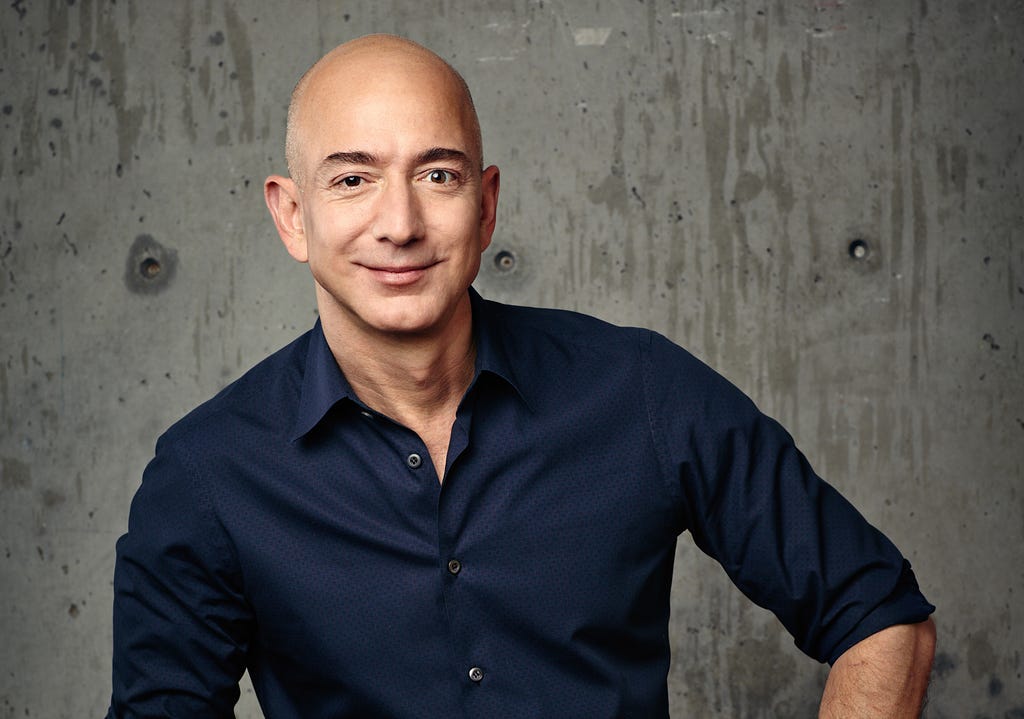Latest news about Bitcoin and all cryptocurrencies. Your daily crypto news habit.

Amazon is an advertising powerhouse.
The company is the third-largest digital advertising platform in the United States and the fifth-largest ad spender. But as CNBC noted in a recent article, Jeff Bezos wasn’t always a believer in advertising. Ten years ago, he said, “Advertising is the price you pay for having an unremarkable product or service.” Why the change of heart? Because Jeff Bezos wants to change the world. And changing the world costs money.
How Amazon Is Changing the World
Jeff Bezos is a market maker. As I wrote in Fast Company in 2013, market makers do more than sell products. They influence beliefs and behaviors. Jeff Bezos is changing how people live and businesses operate through voice and cloud computing.
Voice First
Amazon, along with Google, is ushering in a voice-first world. With astonishing speed, Amazon has unleashed products such as AI-powered smart speakers that rely on voice commands to manage our homes, search for things, purchase goods and services, and navigate our cars.
In the United States, 74.2 million people will use a smart speaker in 2019, according to eMarketer, up 15 percent over 2018. The Amazon Echo smart speaker, introduced in 2014, owns anywhere from 63 percent to 70 percent of the market depending on which source you read. In addition, according to Amazon’s January 31 fourth-quarter earnings announcement, Amazon’s Alexa voice assistant continues to make inroads in the home and the automobile. Meanwhile, Amazon is extending Alexa aggressively into the workplace. Here’s how Bezos’s vision for a voice-first world is playing out:
- In the home: per Amazon, the number of devices with Alexa built-in more than doubled in 2018. More than 150 products have Alexa built in, ranging from headphones to smart home devices. Consumers can choose from 28,000+ Alexa-compatible smart home devices from more than 4,500 brands.
- On the go: more than one million customers requested an invitation for Echo Auto, Amazon’s new Echo designed for vehicles, shortly after Amazon announced its availability. Several automotive partners announced support for Alexa at CES 2019. For example, Telenav, a provider of connected car and location-based services, announced a relationship with Amazon that makes it possible for drivers to use the Telenav Alexa-powered navigation system to do the same kinds of functional tasks that they can do with Google Maps.
- At work: in 2017, Amazon launched Alexa for Business to begin a voice-first transformation inside enterprises. Amazon wants employees of businesses to rely on Alexa to schedule meetings, manage their personal calendars, and handle a host of other tasks. Brooks Brothers and Conde Nast are among the companies that use Alexa for Business to manage meetings according to Amazon. In addition, businesses are creating Alexa skills to manage several functions. To wit: financial services firm TIAA recently announced a new Alexa skill that helps its customers get financial information and obtain customer service. And now that Amazon has made it easy for anyone to create Alexa skills, I predict that so many more businesses are going to adopt Alexa that the creation of an Alexa skill won’t be news.
Jeff Bezos is so enamored with voice that he mentioned Alexa six times in Amazon’s fourth-quarter earnings announcement. In fact, Alexa is about all he talked about in a prepared statement:
Alexa was very busy during her holiday season. Echo Dot was the best-selling item across all products on Amazon globally, and customers purchased millions more devices from the Echo family compared to last year . . . The number of research scientists working on Alexa has more than doubled in the past year, and the results of the team’s hard work are clear. In 2018, we improved Alexa’s ability to understand requests and answer questions by more than 20% through advances in machine learning, we added billions of facts making Alexa more knowledgeable than ever, developers doubled the number of Alexa skills to over 80,000, and customers spoke to Alexa tens of billions more times in 2018 compared to 2017. We’re energized by and grateful for the response, and you can count on us to keep working hard to bring even more invention to customers.
Typically in earnings announcements, CEOs don’t dive into the details of how their products are evolving. But not so with Jeff Bezos. His words demonstrate his belief in the power of voice.
Bezos’s comments about making Alexa more accurate might make him sound a bit geeky, but accuracy matters. Amazon needs to make Alexa more effective at recognizing human speech to make us comfortable using the voice interface to buy things — which is what Jeff Bezos wants us to do while we are on Amazon. Right now, for the most part, people use their smart speakers to check the weather and listen to music. Jeff Bezos’s vision for voice is all about commerce, not checking sports scores. The question is not whether, but when, Amazon will realize that vision.
Cloud Computing
Going hand in hand with voice computing is Bezos’s ambition for businesses and people to manage their lives on a virtual network known as the cloud. Amazon founded its cloud computing business, Amazon Web Services (AWS), in 2006. Today AWS provides the backbone of Amazon’s entire voice ecosystem. When you use Alexa in your home, on the go, or at work, you use AWS.
Bezos envisioned the rise of cloud computing long before voice came along, though, and the cloud powers more than Amazon’s own voice ecosystem. In his 2007 letter to shareholders, he wrote of people using their Kindle e-books to read and record margin notes “on the server-side in the ‘cloud,’ where they can’t be lost.” Eight years later, in his 2015 letter to shareholders, Bezos spoke of the cloud in much more grandiose terms:
Whether you are a startup founded yesterday or a business that has been around for 140 years, the cloud is providing all of us with unbelievable opportunities to reinvent our businesses, add new customer experiences, redeploy capital to fuel growth, increase security, and do all of this so much faster than before.
And he was not exaggerating. By 2015, AWS was providing the backbone for businesses to adapt to the cloud. Today, AWS powers so many companies that it made $25.7 billion in 2018. For example, if you use Airbnb to book a room or Slack to send a message, you’re relying on a business that uses AWS. And Netflix famously relies on AWS to keep its 24/7 content stream going.
Meanwhile, cloud computing, led by AWS, Microsoft, Google, and Alibaba, continues to change how businesses operate — helping them provide services faster and more efficiently around the clock by freeing them from the confines of physical infrastructures. It’s the cloud that makes it possible for Lyft to provide ride-sharing services or Instagram to operate. According to Gartner, the global public cloud services market will grow by 17 percent in 2019 to total $206.2 billion. As with voice, Amazon faces plenty of competition, but Amazon commands the greatest market share.
Where would cloud computing be today without Amazon Web Services?
Vision Costs Money
But building voice and cloud-based products and services costs money. In 2018, Amazon increased its marketing and advertising costs considerably. As noted in CNBC, Amazon reported a $13.8 billion marketing expense for 2018, up 37 percent from the prior year. Nearly 100 million viewers of Super Bowl LIII saw some of that spend in the form of a number of 30-second spots promoting Alexa. Those spots cost $5 million each.
And here is why Amazon’s advertising services, bundled under Amazon Advertising, are so valuable. Amazon Advertising gives Amazon a way to recoup its costs though an increasingly lucrative revenue stream. Through Amazon Advertising, businesses on Amazon promote their products through various forms of display advertising and sponsored product displays that appear in a consumers’ search results on Amazon, similar to how advertising on Google works.
Amazon Advertising is the result of Amazon becoming an increasingly powerful search platform. More people begin their product searches on Amazon than they do on Google. It was only a matter of time before Amazon realized it could monetize that search traffic as Google has done. Businesses are responding. According to a recent study by Nanigans, about one in three marketers are shifting their ad spend from Facebook and Google to Amazon. Amazon Advertising generated $10 billion in 2018.
Amazon’s ambitions for advertising go beyond serving up ads on Amazon itself. As the New York Times reported, Amazon also targets ads to people across the digital world by tapping into the data it has amassed about consumers’ purchases made on Amazon itself. Since Amazon knows exactly what you’ve searched for and purchased on the site, Amazon can advertise for other brands with pinpoint accuracy, as these examples from the New York Times article illustrate:
When a chain of physical therapy centers wanted new patients, it aimed online ads at people near its offices who had bought knee braces recently on Amazon.
When a financial services provider wanted to promote its retirement advisory business, it directed ads to people in their 40s and 50s who had recently ordered a personal finance book from Amazon.
And when a major credit card company wanted new customers, it targeted people who used cards from other banks on the retail site.
The advertisers found those people by using Amazon’s advertising services, which leverage what the company knows better than anyone: consumers’ online buying habits
Just the Cheese, a brand run by Specialty Cheese Company in Reeseville, Wis., makes crunchy dried cheese bars that have taken off as a low-carb snack. By using algorithms to analyze how Just the Cheese’s search ads performed on Amazon’s site, the ad agency Quartile Digital noticed that people who searched for keto snacks and cauliflower pizza crust, both low-carb diet trends, also bought a lot of cheese bars. So Quartile ran display ads across the web targeting Amazon customers who had bought those two specific product categories. Over three months, Amazon showed the ads on websites more than six million times, which resulted in almost 22,000 clicks and more than 4,000 orders.
That 20 percent conversion rate — a sale to one out of five people who clicked on the ads — was “amazing,” Mr. Knijnik said. “That is the kind of powerful granularity for building the target audiences that just Amazon can give you.”
Like other ad networks, Amazon uses cookies and other technical tools to track customers from its site onto other websites. They let the company know that a person who recently bought a diet book is now reading news on CNN and could be targeted on that site with an ad for a protein bar. Amazon does not tell the advertisers who that user is, but it does serve her ads on the brand’s behalf.
And, just like that, Amazon is upending the digital ad industry while creating a mini-industry of companies such as Quartile Digital that offer services related to Amazon’s advertising products. And herein lies an undeniable reality: Amazon giveth, and Amazon taketh. With advertising, Amazon takes business away from established players like Facebook and Google while spurring the launch of new companies that capitalize on Amazon.
“Amazon Is Not Too Big to Fail”
Advertising has helped Jeff Bezos pull off a feat that is extremely hard for a publicly traded firm to do: invest for the long haul while rewarding shareholders in the short term. He also does not take Amazon’s success for granted. As he told employees recently, “Amazon is not too big to fail. In fact, I predict one day Amazon will fail. Amazon will go bankrupt. If you look at large companies, their lifespans tend to be 30-plus years, not a hundred-plus years.”
Whether Jeff Bezos is correct about Amazon’s future remains to be seen. In the meantime, he has helped unleash technologies whose impact is incalculable.
How Advertising Helps Amazon Change the World was originally published in Hacker Noon on Medium, where people are continuing the conversation by highlighting and responding to this story.
Disclaimer
The views and opinions expressed in this article are solely those of the authors and do not reflect the views of Bitcoin Insider. Every investment and trading move involves risk - this is especially true for cryptocurrencies given their volatility. We strongly advise our readers to conduct their own research when making a decision.

